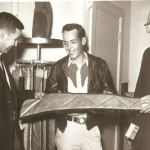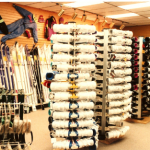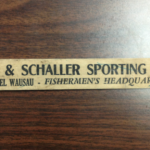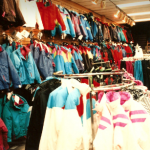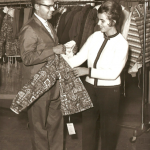Author: tshepherd
Wausau’s Sporting Goods Store
Allen Shepherd and Stan Schaller opened their sporting goods store in downtown Wausau in 1949. The store is still family owned and operated. Here’s a little walk down memory lane.
What’s SUP?
SUPs – Getting Started
What It Is
Maybe you’ve been hearing about SUPs, (Stand Up Paddle Boards)… they’re gaining popularity quickly. There are a number of reasons for the widespread interest, one main one being versatility in the sport. Kids, parents, athletes and relaxed beach-goers alike find a good time atop a SUP. 
Whether your trip out paddling is a time for relaxing, full of adventure, or a great workout depends on where you go and what you’re setting out for. You control your experience (well, unless you’re on raging waters). You put into it what you want, and sometimes a smooth, relaxing venture is just what you need other times it’s all about trying something new, like Yoga on your SUP. Where can you take your SUP out in Central Wisconsin? Anywhere there’s water! (public access allowed of course.) Try Lake Wausau on the Wisconsin River, the Rib River or even Manmade Lake at Sunnyvale Park in Wausau, or one of hundreds of lakes nearby.
What You Need
Get this: you need a SUP and a paddle! Besides that, we suggest playing it safe and always wearing a PFD. We also know the benefits to wearing the right clothing, so we like to recommend swimwear (for days on the water when you’re participating in all sorts of water activities), wet suits when the air or water is cold, or fast drying, wicking performance wear to keep you cool and dry. Sun protection is a biggie too.
After gathering those things, all you need is to get going!
How You Do It
Carry the SUP under your arm or on top of your head and make your way to the water. Starting in shallow water makes stepping onto the board a breeze, but starting kneeling or by sitting then standing works too.
Look for the balance point, and plant your feet there. You don’t want the tail underwater, and you don’t want the nose up in the air. You’ll find a spot that allows your board to stay level. 
Your feet should be about shoulder width apart, centered on the board. Be conscious about keeping your knees soft and back straight and use your hips to keep you centered. Tipping your head or shoulders dramatically will throw you off balance! Ground yourself with your hips.
Hold your adjusted paddle on one side, with your right hand on top when the paddle is on your left side, and vice versa. Be sure the blade of the paddle is all the way under water, and twist with your core to push the paddle back. Keep your strokes small until you’re comfortable. Repeat. And repeat. Change sides after every few strokes to keep yourself heading straight ahead. (You just learned the side stroke.)
You can backpaddle to turn your board, by paddling from the tail of the board to the tip. Stepping back on the board or leaning to the inside of the board will help your board pivot more, making your turn easier and faster.
These are the basics. After you get a hold of these techniques, you’ll have a feel for the board and can manage more water conditions.
What Shep’s Offers
We’ve done our part to have all that you need to get into the sport. We have two boards to choose from, adjustable paddles, life vests, apparel, and yes, even sun screen and sun glasses!


Recommended Bike Commuting Gear for Rookies
The Wausau area just got a little bike friendlier with the recent introduction of a community-wide system of 622 bicycle route signs. Finally! Perhaps you’re thinking that a bike could replace some of the miles you log in a car each day. So do you need any special gear to make commuting a genuine part of your routine? There are a few pieces of equipment that are absolute necessities. And a few more to up the convenience and comfort factor.
The necessities
Bike – Obviously. While there are some seriously cool commuter-specific bikes available it doesn’t really matter what kind of bike you have as long as you’re comfortable. You want to ride a titanium frame racer? Great! A dual-suspension downhill mountain bike? Good for you. A beach cruiser? Cool! As long as you are comfortable riding the bike, ride what you want. Just make sure the bike fits you well, is comfortable and in good working order. If shopping for a new bike makes sense, proceed with caution with regard to department store bikes. Some brands you will find at department stores use lower level components which are not easily exchanged or upgraded. Other brands, however, can be upgraded with new parts and easily customized to make your commute comfy and efficient.

Find a reputable bike shop (preferably locally owned and operated by someone who rides where you do) and speak to someone who can explain the benefits of different bicycles.
Helmet – This is a non-negotiable item. Consider this a very inexpensive insurance policy against head injuries. A helmet is not a magic wand that will keep you from sustaining any injuries, but it can protect you from potentially serious injury that will ruin your day, commute, and possibly much more. Shepherd & Schaller’s adult helmets start at only $35. The investment is worth the price.
Lights – Lights are a must in twilight hours, not to mention in the dark. Unless you are able to commute both directions in daylight, and the weather is never dark or stormy where you live, you need lights. You should have a good bright white light for the front, and at least one red light in the back (preferably one that can be set to flash to be better noticed). Some commuters swear by two lights up front; one bright fixed beam and one flashing LED. The flashing lights are supposed to draw a driver’s attention to the fact that you exist. Some communities, including Wausau, WI, even require lights between dawn and dusk, or longer.
Basic Repair Tools – A patch kit, spare tube, tire irons and an air pump (make sure it’s appropriate for the valves on your particular tubes – Presta or Schroeder ). Having these things with you, and knowing how to use them, will allow you to get yourself going again quickly after a breakdown. Forget them, and you may find yourself hoofing it.
Something to carry your stuff – Backpack, messenger bag, rack and panniers, basket on the front or back of the bike, trailer. Really, it doesn’t matter. There are many, many options out there.

Many backpacks, panniers and messenger bags are made to be truly waterproof, which could be important as well as convenient. Be aware that how you carry your gear may affect your balance and the overall ride. If you can test options out with your typical load it will help you decide how to best carry your things.
Lock – Unless you have a place that provides secure storage for your bike, you’ll want a good lock. Cable locks and light chains come in different weights and will make a thief’s task difficult. Invest in a heavy-duty (and heavy) U-lock such as those made by Kryptonite if your bike is especially attractive to thieves to further reduce risk.
Knowledge of traffic laws applicable to cycling – Most are the same as the rules that apply to motorists, but there are some differences. Know them and follow them. You can be given a ticket for breaking them.
Optional Items
Special clothing – You can ride in your work clothes. In fact, if it’s a short ride, it may be preferable. If you have a longer ride, bike specific clothing will add comfort and performance, and doesn’t always fit like a glove or glow in the dark (although reflective features are a really good idea, if only on your shoes.) Padded bike shorts are often the first thing commuters add to their shopping bag.
Rain Gear – Something to keep you dry from the outside, and preferably something that vents well to keep you dry on the inside as well. Most rain jackets and pants roll-up or stuff into a self-pocket for storage that doesn’t take up much room. Again, reflective hits on rain gear make you visible to motorists.
Fenders – These are great to keep the road muck off your clothing in the rain. If you choose to commute in your street clothes these may move into the necessity category if you hope to avoid going into that business meeting or classroom with a stripe of mud up your back.
Water bottle or “hydration system” – A ride of just a few blocks probably won’t require this, but it’s always good to have something to satisfy your thirst as you ride. For longer commutes, it will become more of a necessity.
Bell – Or a horn. It’s not only polite to let pedestrians and other riders know you’re coming up behind them, your bell can improve your safety.
With so many resources at your fingertips, bike commuting may be the easiest new habit you adopt. If you have more commuting questions or concerns, commutebybike.com is your next stop.
Shepherd & Schaller’s professional bike shop specializes in customization and will install your bike new accessories for free. (those you buy from us) Plus, meet with Pete for fit adjustments and one-on-one advise to plan your commute in all the weather that Wisconsin offers.
Stop Bugging Me
Warm temps and standing water mean insects are hatching at your favorite parks, campsites and back yards. Great. You know that protection from insect-born illnesses is smart and itchy bites are not just annoying but risk infection. So what’s an outdoor lover like you to do? Read what our friends at the CDC recommend (below) and stop in for products that get the job done. Shepherd & Schaller stocks professional grade repellents. Which one is for you?
Q. Why should I use insect repellent?
A. Insect repellents can help reduce exposure to mosquito bites that may carry viruses such as West Nile virus that can cause serious illness and even death. Using insect repellent allows you to continue to play and work outdoors with a reduced risk of mosquito bites.
Q. When should I use mosquito repellent?
A. Apply repellent when you are going to be outdoors. Even if you don’t notice mosquitoes there is a good chance that they are around. Many of the mosquitoes that carry West Nile virus bite between dusk and dawn. If you are outdoors around these times of the day, it is especially important to apply repellent. In many parts of the country, there are mosquitoes that also bite during the day, and some of these mosquitoes have also been found to carry West Nile virus.
Q. How often should repellent be reapplied?
A. In general you should re-apply repellent if you are being bitten by mosquitoes. Always follow the directions on the product you are using. Sweating, perspiration or getting wet may mean that you need to re-apply repellent more frequently.
Repellents containing a higher concentration (higher percentage) of active ingredient typically provide longer-lasting protection.
Q. How does mosquito repellent work?
A. Female mosquitoes bite people and animals because they need the protein found in blood to help develop their eggs. Mosquitoes are attracted to people by skin odors and carbon dioxide from breath. The active ingredients in repellents make the person unattractive for feeding. Repellents do not kill mosquitoes. Repellents are effective only at short distances from the treated surface, so you may still see mosquitoes flying nearby.
Active Ingredients (Types of Insect Repellent)
Q. Which mosquito repellents work best?
A. CDC recommends using products that have been shown to work in scientific trials and that contain active ingredients which have been registered with the US Environmental Protection Agency (EPA) for use as insect repellents on skin or clothing. When EPA registers a repellent, they evaluate the product for efficacy and potential effects on human beings and the environment. EPA registration means that EPA does not expect a product, when used according to the instructions on the label, to cause unreasonable adverse effects to human health or the environment.

Of the active ingredients registered with the EPA, CDC believes that two have demonstrated a higher degree of efficacy in the peer-reviewed, scientific literature . Products containing these active ingredients typically provide longer-lasting protection than others:
• DEET (N,N-diethyl-m-toluamide)
• Picaridin (KBR 3023)
Oil of lemon eucalyptus [active ingredient: p-menthane 3,8-diol (PMD)], a plant- based repellent, is also registered with EPA. In two recent scientific publications, when oil of lemon eucalyptus was tested against mosquitoes found in the US it provided protection similar to repellents with low concentrations of DEET.

Q. How does the percentage of active ingredient in a product relate to the amount of protection it gives?
A. Typically, the more active ingredient a product contains the longer it provides protection from mosquito bites. The concentration of different active ingredients cannot be directly compared (that is, 10% concentration of one product doesn’t mean it works exactly the same as 10% concentration of another product.)
DEET is an effective active ingredient found in many repellent products and in a variety of formulations. Based on a 2002 study (Fradin and Day, 2002.)
• A product containing 23.8% DEET provided an average of 5 hours of protection from mosquito bites.
• A product containing 20% DEET provided almost 4 hours of protection
• A product with 6.65% DEET provided almost 2 hours of protection
• Products with 4.75% DEET were both able to provide roughly 1 and a half hour of protection.
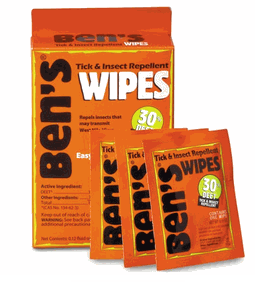
These examples represent results from only one study and are only included to provide a general idea of how such products may work. Actual protection will vary widely based on conditions such as temperature, perspiration, and water exposure.
Choose a repellent that provides protection for the amount of time that you will be outdoors. A product with a higher percentage of active ingredient is a good choice if you will be outdoors for several hours while a product with a lower concentration can be used if time outdoors will be limited. Simply re-apply repellent (following label instructions) if you are outdoors for a longer time than expected and start to be bitten by mosquitoes.
Q. Why does CDC recommend certain types of insect repellent?
A. CDC recommends products containing active ingredients which have been registered with US Environmental Protection Agency (EPA) for use as insect repellents on skin or clothing.
All of the EPA-registered active ingredients have demonstrated repellency however some provide more longerlasting protection than others. Additional research reviewed by CDC suggests that repellents containing DEET (N,N-diethyl-m-toluamide) or picaridin (KBR 3023) typically provide longer-lasting protection than the other products and oil of lemon eucalyptus (p-menthane-3,8-diol) provides longer lasting protection than other plant-based repellents. Permethrin is another long-lasting repellent that is intended for application to clothing and gear, but not directly to skin. In general, the more active ingredient (higher concentration) a repellent contains, the longer time it protects against mosquito bites.
People who are concerned about using repellents may wish to consult their health care provider for advice. The National Pesticide Information Center (NPIC) can also provide information through a toll-free number, 1-800-858-7378 or npic.orst.edu

Q. How can you know which active ingredient a product contains?
A. Check the product label if you have questions-–repellents must specify their active ingredients. In some cases you will note the chemical name in addition to/instead of the “common” name:
• DEET is N,N-diethyl-m-toluamide
• Picaridin is KBR 3023, sometimes known as “Bayrepel” outside the US
• The active ingredient in oil of lemon eucalyptus is p-menthane 3,8-diol (PMD)
Q. What is permethrin?
A. Certain products which contain permethrin are recommended for use on clothing, shoes, bed nets, and camping gear, and are registered with EPA for this use. Permethrin is highly effective as an insecticide and as a repellent. Permethrin-treated clothing repels and kills ticks, mosquitoes, and other arthropods and retains this effect after repeated laundering. The permethrin insecticide should be reapplied following the label instructions. Some commercial products are available pretreated with permethrin.

Q. Where can I find these repellents?
A. Shepherd & Schaller Sporting Goods has Deet, Permethrin and Oil of Lemon Eucalyptus repellents in stock in Downtown Wausau, Wisconsin and online at www.shepssports.com.
Q. Where can I find more information about picaridin?
A. More information is available from EPA (Environmental Protection Agency (EPA).
Using Repellents Properly
Q. What are some general considerations to remember when using insect repellents?
A. Always follow the recommendations appearing on the product label.
• Use enough repellent to cover exposed skin or clothing. Don’t apply repellent to skin that is under clothing. Heavy application is not necessary to achieve protection.
• Do not apply repellent to cuts, wounds, or irritated skin.
• After returning indoors, wash treated skin with soap and water. (This may vary depending on the product. Check the label.)
• Do not spray aerosol or pump products in enclosed areas.
• Do not spray aerosol or pump products directly to your face. Spray your hands and then rub them carefully over the face, avoiding eyes and mouth.
Q. What are some reactions to be aware of when using insect repellents?
A. Use of repellents products may cause skin reactions in rare cases. Most products also note that eye irritation can occur if product gets in the eye. If you suspect a reaction to a product, discontinue use, wash the treated skin, and call a poison control center. If product gets in the eyes flush with water and consult health care provider or poison control center. If you go to a doctor, take the product with you.
There is a national number to reach a Poison Control Center near you: 1-800-222-1222.
Children
Q. Can insect repellents be used on children?
A. Repellent products must state any age restriction. If there is none, EPA has not required a restriction on the use of the product.
According to the label, oil of lemon eucalyptus products should NOT be used on CHILDREN UNDER 3 YEARS.
In addition to EPA’s decisions about use of products on children, many consumers also look to the opinion of the American Academy of Pediatrics (AAP). The AAP does have an opinion on the use of DEET in children (see below). AAP has not yet issued specific recommendations or opinion concerning the use of picaridin or oil of lemon eucalyptus for children. CDC will post a link to such information from the Academy when/if it becomes available.
Since it is the most widely available repellent, many people ask about the use of products containing DEET on children. No definitive studies exist in the scientific literature about what concentration of DEET is safe for children. No serious illness has been linked to the use of DEET in children when used according to manufacturer’s recommendations.
The American Academy of Pediatrics (AAP) Committee on Environmental Health has updated their recommendation for use of DEET products on children in 2003, citing: “Insect repellents containing DEET (N,N-diethyl-m-toluamide, also known as N,N-diethyl-3-methylbenzamide) with a concentration of 10% appear to be as safe as products with a concentration of 30% when used according to the directions on the product labels.” AAP recommends that repellents with DEET should not be used on infants less than 2 months old. Parents should choose the type and concentration of repellent to be used by taking into account the amount of time that a child will be outdoors, exposure to mosquitoes, and the risk of mosquito-transmitted disease in the area.
If you are concerned about using repellent products on children you may wish to consult a health care provider for advice or contact the National Pesticide Information Center (NPIC) through their toll-free number, 1-800-858-7378 or npic.orst.edu
Q. What guidelines are available for using a repellent on children?
A. Always follow the recommendations appearing on the product label when using repellent:
• When using repellent on a child, apply it to your own hands and then rub them on your child. Avoid children’s eyes and mouth and use it sparingly around their ears.
• Do not apply repellent to children’s hands. (Children may tend to put their hands in their mouths.)
• Do not allow young children to apply insect repellent to themselves; have an adult do it for them.
• Keep repellents out of reach of children.
• Do not apply repellent under clothing. If repellent is applied to clothing, wash treated clothing before wearing again. (May vary by product, check label for specific instructions.)
Q. How else can I protect children from mosquito bites?
A. Using repellents on the skin is not the only way to avoid mosquito bites. Children (and adults) can wear clothing with long pants and long sleeves while outdoors. DEET or other repellents such as permethrin can also be applied to clothing (but is not registered for use on skin), as mosquitoes may bite through thin fabric. Mosquito netting can be used over infant carriers. Finally, it may be possible to reduce the number of mosquitoes in the area by getting rid of containers with standing water that provide breeding places for mosquitoes.
Q. Can insect repellents be used by pregnant or nursing women?
A. Other than the routine precautions noted earlier, EPA does not recommend any additional precautions for using registered repellents on pregnant or lactating women. Consult your health care provider if you have questions.
Insect Repellents containing DEET and Sunscreen
Q. Can I use an insect repellent and a product containing sunscreen at the same time? What are the recomendations for combination sunscreen/insect repellent products ?
A. Yes. People can, and should, use both a sunscreen and an insect repellent when they are outdoors. Follow the instructions on the package for proper application of each product. In general, the recommendation is to apply sunscreen first, followed by repellent.
It is recommended NOT to use a single product that combines insect repellent containing DEET and sunscreen, because the instructions for use of insect repellents and use of sunscreen are different. In most situations, insect repellent does not need to be reapplied as frequently as sunscreen. While no recommendations are available at this time regarding products that combine other active ingredients and sunscreen, it is important to always follow the label on whatever product you are using.
To protect from sun exposure and insect bites, you can also wear long sleeves and long pants. You can also apply insect repellent to your clothing, rather than directly to your skin.
More Information
Q. Where can I get more information about repellents?
A. For more information about using repellents, please consult the Environmental Protection Agency (EPA) Web site or consult the National Pesticide Information Center (NPIC), which is cooperatively sponsored by Oregon State University and the U.S. EPA. NPIC can be reached at: npic.orst.eduor 1-800-858-7378.





